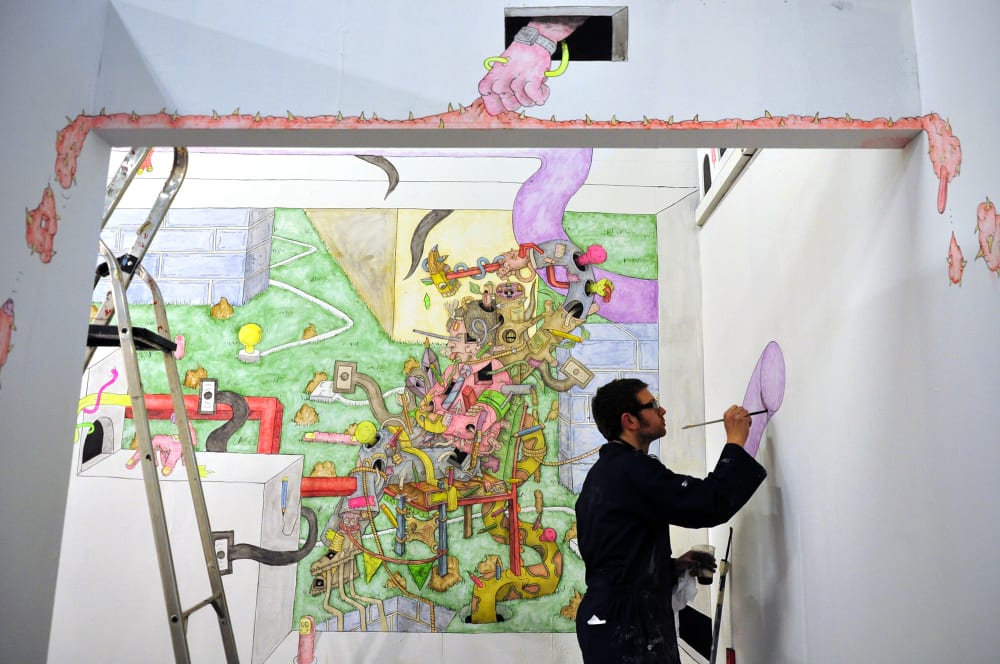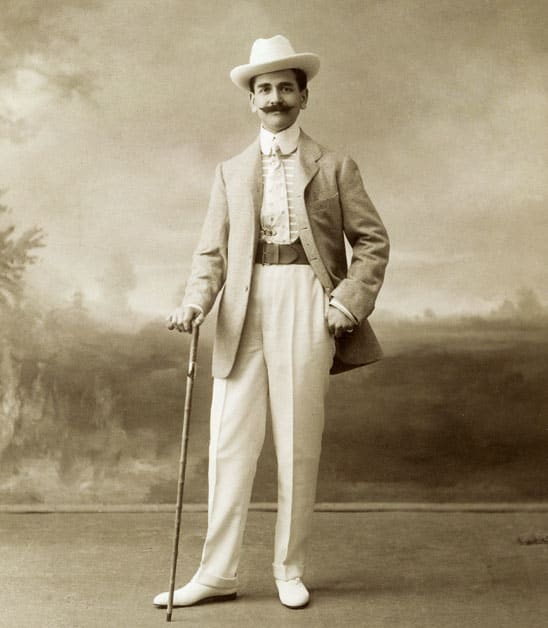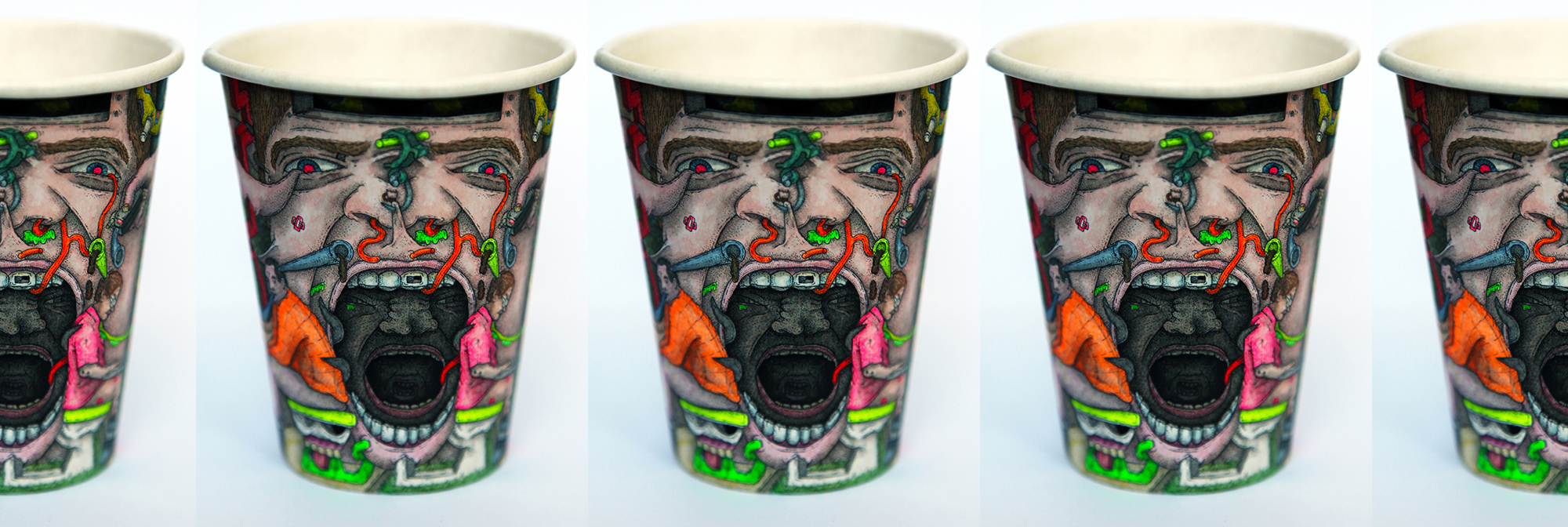Visitors to Wimbledon Space this term are invited to enter into the hallucinatory and surreal world of Raymond Roussel (1877-1933), one of the most influential yet unknown writers of the 20th Century.
From February to the end of term, the artist Paul Westcombe will be working ‘in situ’ at Wimbledon creating an immersive experience combining elements of drawing, painting, and opera in his collaboration with the dramatic soprano Katrina Sheppeard.
As Wimbledon prepares to enrol performance students in the next academic year and students of fine art are on site for 2 more years before the courses are relocated to Camberwell’s expanded site at Peckham Road, could the ‘A Soul Twirler Booms Trout Wet’ aesthetic be a taste of things to come a the Wimbledon campus? It could just be a pre-cursor to a whole number of creative collaborations that emerge as the worlds of fine art and performance share space and work alongside each other at Wimbledon’s Merton Hall Road site.
“The exhibition is an exploration and experimentation of my own practice,” says the artist Paul Westcombe. “I completed an MA in Painting the Royal College of Art (2007) and then later studied for a Postgraduate Diploma in Scenic Art at RADA (2017). ‘A Soul Twirler Booms Trout Wet’ conjoins elements from scenic art, i.e. stage painting and backdrops, with those of painting and drawing and examines how these world scan co-exist.”

, Wimbledon College of Arts, UAL
Paul Westcombe has had a long time fascination with Roussel and is thrilled to be able to initiate this project at Wimbledon Space, “I first came across him after reading Foucault’s ‘Death and the Labyrinth: The World of Raymond Roussel’ which has been described as Foucault’s love letter to the writer.
“He was definitely a visionary writer, mesmerising dandy, radical traveller, eccentric President of the Republic of Dreams who produced a massive amount of work.
“Widely regarded as a failure, he paid for most of his output to be produced himself, in what would be regarded as vanity publishing in today’s terms.”
But what a failure. “Roussel is now widely thought of as having been the inspiration to some of the most influential artists of the 20th century including Duchamp, Giacometti, Breton and of course, Foucault,” continues Westcombe.
“He regularly corresponded with Salvador Dali and it is said that when Dalí died, a copy of Roussel’s ‘Impressions of Africa’ was found by his side.” Roussel was born in Paris into a wealthy family, and had been groomed by his overbearing mother to be a musician. But at age nineteen, working on what would become his first published book, he describes “a sensation of universal glory” that attended his writing process and decided that he was in fact a prodigy with the talent of Dante no less, and declared “My fame will outshine that of Victor Hugo or Napoleon.”

, Wimbledon College of Arts, UAL
However, not quite everyone agreed with Roussel’s self-assessment (his own psychiatrist regarded him as a lunatic) and he became progressively unstable after the publication of his first book. After that he came to develop a near-mechanical technique of writing. The French public didn’t take to, or failed to understand, the incomprehensible world of Raymond Roussel. Crushed by their indifference, he died of an overdose, ostensibly suicide, in a Palermo hotel room in 1933.
In his final work, ‘How I Wrote Certain of My Books’, which was published in 1935 after his death, Roussel explained the unusual methods he used to compose his novels ‘Impressions of Africa’ and ‘Locus Solus’ and all he dared to hope for was “a little posthumous fame.”
In ‘How I Wrote Certain of My Books’, Roussel elucidates on his methods of uniting near-homonyms, such as ‘billiard’ and ‘pillard’ (pill and looter), and letting a narrative arise from their juxtaposition. Roussel’s enviable task was then to reconcile the two separate concepts via a connecting narrative which was how some of his fantastical episodes came to life.
As you might imagine from an exhibition that is about an ultra-experimental author known for wild wordplay, A Soul Twirler Booms Trout Wet will adopt an aesthetic that is multi-faceted and multi-dimensional to create an immersive sensory experience where nothing can be taken at face value.
As well as painting and drawing Paul works in a number of theatrical and operatic contexts, so he was keen to collaborate with a performer on this project. Enter Katrina Sheppeard, a dramatic soprano who has performed on many of the world’s leading opera stages. Sheppeard has appeared at the Sydney Opera House and the Coliseum (home to the English National Opera) where she has performed many roles, including the leading role in ‘Norma’ - widely regarded as one of the most demanding in the repertoire.
“When Paul told me about Roussel, and the codes and tricks he used for creating his works, I was reminded of how many of the great composers, including Bach and Shostakovich, had famously used cryptograms (or secret codes). They used them to create musical motifs to write themselves and their friends’ names into their works.

, Wimbledon College of Arts, UAL | Photograph: Minako Jackson
“There was actually a musical cryptogram known as the ‘French method’ which was in use during Roussel’s lifetime and, given his nationality, I wondered whether we should apply this to the text that Paul has selected.”
The French method’s most popular version involved writing out the letters H-N, O-U and V-Z in lines under the original diatonic notes A-G, as in the diagram. “A, H, O, and V are enciphered by note ‘A’, B, I, P and W by ‘B’ (flat or natural) and so on.” said Katrina.
“A recurring theme in Roussel’s work is the dis-embodied head. Visitors will see a talking head and hear her ‘operatic’ take on the text” says Paul. “With Roussel nothing is quite what it seems, so the rhythmic structure of Katrina’s vocals will also contain a hidden morse code containing a secret message for the listener.
“I’ve conceived the piece with the intention of triggering events, happenings and artworks in Wimbledon Space and we will be inviting students from costume, production arts and fine art - in fact the whole college - to get involved. I will be painting and drawing directly on the surfaces of the gallery and I want its objects, alcoves and architecture to become part of the piece.”
And what of the exhibition when it has run its course? “History tends to record the works of those that achieve acclaim in their own lifetime, so much of Roussel’s work is long forgotten.” says Paul.
“There was such a fleeting nature to his life and work. So much of it was temporary and transient. The works I create for ‘A Soul Twirler Booms Trout Wet’ will be removed and destroyed but I hope a memory might linger, ghost-like, in the minds of visitors to the Wimbledon Space. So perhaps Roussel will live on.”
A Soul Twirler Booms Trout Wet is on at Wimbledon Space from 18 February - 18 March 2019.

